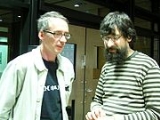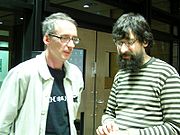
Alexei Shulgin
Encyclopedia

Russia
Russia or , officially known as both Russia and the Russian Federation , is a country in northern Eurasia. It is a federal semi-presidential republic, comprising 83 federal subjects...
n born contemporary artist, musician, and online curator. Working out of Moscow and Helsinki, Shulgin established the Immediate Photography Group in 1988 and started his career in this area of study. After 1990, he shifted his interests from photography to the Internet, and consequently, in 1994, founded Moscow-WWW-Art-Lab WWW Art Lab, collaborating with many artists from London
London
London is the capital city of :England and the :United Kingdom, the largest metropolitan area in the United Kingdom, and the largest urban zone in the European Union by most measures. Located on the River Thames, London has been a major settlement for two millennia, its history going back to its...
and Slovenia
Slovenia
Slovenia , officially the Republic of Slovenia , is a country in Central and Southeastern Europe touching the Alps and bordering the Mediterranean. Slovenia borders Italy to the west, Croatia to the south and east, Hungary to the northeast, and Austria to the north, and also has a small portion of...
. That very same year, the artist created an online photo museum called "Hot Pictures". In 1997, Shulgin continued his work with the invention of Form Art (Form Art), and later that year the introduction of the easy life website (Easy Life). In 1999, Shulgin became Webmaster at FUFME, Inc. Since 2004, Shulgin has been a co-owner of Electroboutique (Electroboutique).
Highlights
Particularly involved with software artSoftware art
Software art refers to works of art where the creation of software, or concepts from software, play an important role; for example software applications which were created by artists and which were intended as artworks. As an artistic discipline software art has attained growing attention since the...
and internet art
Internet art
Internet art is a form of digital artwork distributed via the Internet. This form of art has circumvented the traditional dominance of the gallery and museum system, delivering aesthetic experiences via the Internet. In many cases, the viewer is drawn into some kind of interaction with the work...
, he is a part of the readme
README
A readme file contains information about other files in a directory or archive and is commonly distributed with computer software. Such a file is usually a text file called README.TXT, README.1ST, READ.ME, or simply README, although some Microsoft Windows software may occasionally include a...
culture, and is probably most well-known for his ongoing so called "386DX" performances, in which he manipulates an antiquated computer with Microsoft Windows
Microsoft Windows
Microsoft Windows is a series of operating systems produced by Microsoft.Microsoft introduced an operating environment named Windows on November 20, 1985 as an add-on to MS-DOS in response to the growing interest in graphical user interfaces . Microsoft Windows came to dominate the world's personal...
version 3.1 and an Intel 386
Intel 80386
The Intel 80386, also known as the i386, or just 386, was a 32-bit microprocessor introduced by Intel in 1985. The first versions had 275,000 transistors and were used as the central processing unit of many workstations and high-end personal computers of the time...
processor to perform MIDI (Musical Instrument Digital Interface) renditions of popular music hits while a synthesized text-to-speech voice "sings" the lyrics. Shulgin describes his project, which he began in 1998, of electronic covers as "the world's first cyberpunk rock band." Shulgin and his software have given live performances in many different locals all over the world, from the San Diego/Mexico border, with Shulgin on one side and his computer on the other, to the streets of Graz
Graz
The more recent population figures do not give the whole picture as only people with principal residence status are counted and people with secondary residence status are not. Most of the people with secondary residence status in Graz are students...
, Austria
Austria
Austria , officially the Republic of Austria , is a landlocked country of roughly 8.4 million people in Central Europe. It is bordered by the Czech Republic and Germany to the north, Slovakia and Hungary to the east, Slovenia and Italy to the south, and Switzerland and Liechtenstein to the...
, where the machine was actually given money as if it were a real person for playing the music. Shulgin encourages his audience to also manipulate the early Microsoft software- with the self release of his cover songs on an enhanced cd titled The Best of 386 DX, which included the same first version of Microsoft that he used.
In 1997, he released his first interactive work, Form Art, in which only minimum factors are programmed in the form of HTML. Shulgin describes this page as a "formalistic" aesthetical art site”. Navigating this site requires aimless click-throughs of blank boxes and links, which lead the viewer through countless pages of “form art” animations made up of Shulgin’s boxes. Some of the more interesting discoveries on the page include a “Gomputer Game”, which allows the viewer to make arbitrary decisions upon which link to cick- sometimes leading to the next round, other times often merely ending up at the “you lose” page. From the homepage of Shulgin’s Form site however, one can navigate to a list of the artist’s resume and their respective links. The webpage could very well be several years old if the latest postings accurately read “1997”, making this an interesting look into the early internet tools via HTML. This was aimed at the influence of a networking process on the Internet.
Shulgin’s easy life website has a link to his net.art work which gives his audience a regular magna carta of his net.art ideals. Collaborating with Natalie Bookchin (another web artist and professor of Visual Arts at the University of California, San Diego) on the website, both authored an outline of their many goals in creating net.art and give a step by step guideline with tips and tricks for others looking to fashion online art in the same vein as what they have produced. According to http://www.easylife.org/netart/, “net.art” is defined as “a self-defining term created by a malfunctioning piece of software, originally used to describe an art and communications activity on the internet”. By the simple act of creating art on the web, the outline indicates that one is breaking down “autonomous disciplines and outmoded classifications imposed upon various activists practices” and thereby “by an artist/individual could be equal to and on the same level as any institution or corporation”.
Many of the links on Shulgin’s easy life webpage no longer link to existing pages, however there are a few, aside from the net.art and form pages, that stand out. “Desktop IS” http://www.easylife.org/desktop/desktops.html is a project which reveals the contents of a few dozen participants actual desktops, and provides links to their contents. “Turn off the tv set” http://www.desk.nl/~you/turnoff/ is another example of Shulgin’s net.art work in action, whereby the viewer is able to turn off and on a small television set in the middle of the screen, and from there the user is invited to interactively “channel surf” the set from the web. “Remedy for Information Disease” http://www.desk.nl/~you/remedy/ is one of the latest links provided on the easy life page. On the first page, the viewer is informed that “All is flashing in front of our eyes: people, news, goods, theories, images...” and they are invited to utilize their “specially developed, tested, non- aggressive, refreshing, meditative flow of flashing” in the form of various .gifs.
Another facet of Shulgin’s work are his three sites which he lists at the end of his easy life website and describes as “domain name (kind of) poetry”, are “Link X”, “ABC”, and “IBM”(http://www.desk.nl/~you/linkx/, http://www.desk.nl/~you/abc/, http://www.desk.nl/~you/ibm/). By visiting any one of these pages, the viewer is presented with a list or collection of words or letters, such as “bookmark” or “abc”, respectively, in the form of links. Clicking on any of the links then takes the viewer to a URL correlating to the word that took them there using a tool called a Uniform Resource Locator. For example, from the ABC webpage, the viewer can click on the link titled “aaa”, which would then take them to the Triple A insurance website. Clicking on “mmm” takes the viewer to the 3M Worldwide site. Tilman Baumgaertel, webmaster of art.teleportacia.org, describes this experience: “users, who follow the links that the artist has given to his audience, will find themselves in awe about the rich esthetic experiences that these internet addresses provide”. He later adds, “while www.iii.com takes the net.art lover to the homepage of "Innovative Interface Inc.", www.ggg.com is the URL of "Great Glorious Grapevine" and www.xxx.com lures us into the seductive environment of a "Sexroulette" game.”
External links
- easylife.org website
- http://pzwart.wdka.hro.nl/mdr/research/ashulgin
- https://wiki.brown.edu/confluence/display/MarkTribe/Alexei+Shulgin
- http://sunsite.cs.msu.su/wwwart

